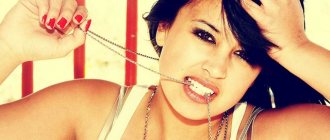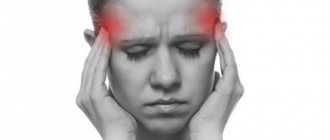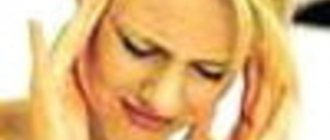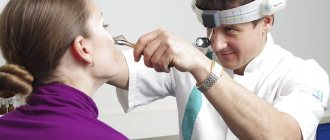Causes of pain in the back of the head on the left side of the head
Pain and discomfort are not a separate disease, so there are many reasons why the left back of the head hurts. The simplest ones are fatigue, lack of sleep, strong emotions, high air pollution. They pass immediately after rest and creation of comfortable conditions. Also, this symptom may indicate a number of diseases of the cervical spine, blood vessels and nerves, which require timely diagnosis and treatment.
Diseases of the cervical spine
If the occipital part of the head on the left hurts, it is important to conduct an examination of the cervical spine. It is here that the important vertebral artery passes, which carries blood to the head and nourishes nerve tissue. Pathological formations in the vertebral area, bone calluses, muscle spasms lead to compression and a decrease in blood flow to the brain.
- Osteochondrosis is a chronic disease of the intervertebral discs and joints associated with a slowdown in metabolism and blood circulation. It often occurs in older people, but can also result from injuries and diseases of the spine at any age. The cartilage becomes thin and inelastic, and the process of deformation of the vertebrae and the formation of bone calluses begins.
- Protrusion – protrusion of intervertebral discs in any direction. The pathological process goes through several stages, the last of which is a hernia. It occurs with rupture of the dense fibrous membrane and release of the cartilage contents. In advanced cases, treatment requires surgery.
- Displacement of the vertebrae - often due to injuries and falls, but can also be a consequence of weak ligaments. The process is accompanied by acute pain in the neck, compression of blood vessels and nerve roots. The pain in the occipital part of the head on the left is sharp, throbbing, intensifies during movements and turns of the head. It goes away if the normal position of the vertebrae is restored, but it is important to prevent them from being displaced again.
Treatment tactics for various diseases of the cervical spine will differ. It is important to eliminate the cause of compression of blood vessels and nerves, restore normal blood supply and innervation of tissues. For most patients, massage, gymnastics, and taking muscle relaxants and antispasmodics are sufficient, but in some cases surgical intervention may be necessary.
Muscle diseases in the neck area
Muscle spasms and inflammation of soft tissues are one of the reasons why the left back of the head hurts. Discomfort spreads to the neck and occipital region, and can affect the entire surface of the head. During diagnosis, a number of muscle pathologies in the cervical region can be determined, which cause an acute headache in the left occipital region.
- Myositis is inflammation of the muscles. The process can be of traumatic or infectious origin, or result from hypothermia of the neck and head. The pain is acute and persists even at rest, and the skin over the affected area becomes inflamed and acquires a red tint. For most patients, anti-inflammatory and analgesic ointments are sufficient for treatment.
- Muscle strain is a micro-tear of fibers. This damage occurs as a result of sudden movements of the neck, falls, or prolonged exposure to an uncomfortable position. The most dangerous is a complete rupture of the muscle - it must be restored surgically.
- Myogelosis is a disease in which painful lumps form in the muscles. They limit the mobility of the cervical spine, compress blood vessels and nerves, and lead to the formation of ischemic areas in the brain. For treatment, muscle relaxants, massage and physiotherapy sessions are prescribed.
One of the reasons why the left occipital part of the head hurts is a sedentary lifestyle, working at a monitor. Lack of movement causes muscle spasms, slow blood circulation, and ischemia of brain tissue. Doctors at the Clinical Brain Institute recommend periodically warming up during the working day to maintain vascular health.
Nerve diseases
If the back of the head on the left side of the head hurts severely, this may be a manifestation of neuralgia. The pain is acute, throbbing, and persists both during movement and at rest. Its source is the greater occipital nerve, which originates from the second cervical root and passes under the base of the skull. Painful sensations can be caused by the following pathologies:
- neuritis - inflammation of the nerve;
- mechanical compression, pinching of nerve fibers;
- incorrect posture;
- diseases of the cervical spine associated with anomalies in the location of the vertebrae;
- abnormal physical activity.
Neuralgia can occur in acute or chronic forms. It is often shooting and has a high intensity. When the greater occipital nerve is damaged, it spreads to the neck and back of the head. Treatment depends on the cause of the pain. In case of mechanical compression of the nerve, it is important to restore its conductivity; in case of infectious diseases, a course of antibacterial therapy is prescribed. At home, you can additionally use ointments with the addition of painkillers and anti-inflammatory components.
Vascular diseases
Pain in the back of the head on the left side of the head is a reason to undergo a vascular examination. Spasms, inflammatory and dystrophic processes lead to deterioration of blood circulation. Areas appear in the brain that are deficient in oxygen and nutrients. There are a number of diseases that manifest themselves as pain in the left or right back of the head, associated with pathologies of the vascular system.
- Hypertension is a chronic increase in blood pressure. It often manifests itself in older people, and can also be associated with abnormalities in the structure of blood vessels, physical activity, and metabolic disorders. The walls of the arteries gradually stretch under blood pressure, becoming thin and inelastic. Hypertension is one of the main risk factors for the development of hemorrhagic stroke.
- Hypotension is a decrease in blood pressure. Its causes include heart disease, insufficient vascular tone, anemia and other factors. If the condition occurs frequently, you must follow a special diet and take medications to increase your blood pressure. Long-term oxygen deficiency negatively affects brain function, leads to headaches, and can provoke an attack of ischemic stroke.
- Atherosclerosis is a disease of large arteries associated with impaired lipid metabolism. Excess cholesterol and some fractions of lipoproteins accumulate on the inner wall of blood vessels, forming deposits and plaques. Detecting this disease at an early stage will prevent its further development. In the later stages, atherosclerosis is dangerous due to the complete blocking of the lumen of the vessel, as well as rupture of its walls.
Fluctuations in blood pressure and vascular disease are one of the risk factors for stroke. This is a dangerous condition that represents an acute cerebrovascular accident. An attack occurs either when an artery ruptures, or due to a prolonged lack of oxygen in certain areas. The treatment and rehabilitation regimen depends on the type of stroke and the size of the affected area, as well as the age of the patient and the presence of concomitant diseases.
Other reasons
If the left side of the back of the head hurts, it is worth undergoing a detailed diagnosis and determining the exact cause of this symptom. During the examination, it is important to indicate all the conditions for the appearance of painful sensations, as well as additional complaints. Discomfort can be associated with a variety of diseases and conditions, including:
- migraine;
- prolonged fatigue, stress and insomnia;
- poor nutrition, excessive consumption of fatty and salty foods;
- sedentary lifestyle.
In most cases, pain in the back of the head on the left goes away after proper rest. Doctors at the Clinical Institute of the Brain recommend that you seek examination if painful sensations occur frequently or are acute.
Unfavorable factors
Various disorders in the body can cause an abnormal condition. Most often this is associated with the functionality of the spine, its diseases (osteochondrosis, hernia, tumors of various types, spondylosis, previous trauma). These disorders lead to compressive pressure on the roots of the nerve canals, which causes severe pain to be transmitted to the central nervous system. Each touching of a nerve, its compression leads to an attack.
There is a high probability of pain paresis with previously diagnosed diseases:
- trigeminal neuritis;
- traumatic brain injury;
- damage to the glossopharyngeal processes;
- aneurysm, hematoma, tumor formations and cysts;
- osteomyelitis of the jaw.
A previous infection can also become an unfavorable factor, since extensive inflammation damages the internal organs of hearing and smell, and affects the intracranial nerve pathways.
Examination methods
If the occipital part of the head on the left often hurts, it is important to undergo a full diagnosis. During the initial examination, the therapist prescribes additional examinations from specialized specialists, as well as the necessary tests:
- blood tests to determine its composition, identify viral and bacterial infections and obtain other indicators;
- X-ray or MRI of the cervical spine if disease in this area is suspected;
- examination of the vessels of the neck and head using Dopplerography - ultrasound diagnostics using a contrast agent;
- MRI, CT scan of the brain is an accurate, informative technique for detecting neoplasms, hemorrhages and other pathologies that can cause headaches;
- specific examinations by a neurologist, traumatologist, ophthalmologist and other specialized specialists according to indications.
The Clinical Institute of the Brain has all the necessary conditions for diagnosing diseases that are accompanied by headaches. Accurate test results, high-quality modern equipment, many years of experience of specialists are the main advantages of the center.
Diagnostics
The nature of the pathology is determined by a neurologist. According to indications, an orthopedist-traumatologist, an infectious disease specialist, and other specialists are involved in the examination. The doctor finds out the time of onset, duration and nature of the pain syndrome, and identifies other symptoms. When collecting anamnesis, the doctor pays attention to possible provoking factors and the presence of chronic diseases.
Examination of the back of the head may indicate external changes (swelling, wounds, abrasions). Palpation sometimes reveals tension, muscle tightness, and enlarged lymph nodes. A neurological examination involves assessing reflexes, muscle strength, various types of sensitivity, and detecting focal disorders. To clarify the diagnosis, the following are prescribed:
- X-ray examination
. Indications for radiography of the skull are fractures of the occipital bone, for radiography of the cervical vertebrae - subluxations, spondylitis, osteochondrosis, hernias. - CT scan.
Allows you to detail the data obtained during radiography. The contrast technique displays changes in blood vessels. - Magnetic resonance imaging.
It visualizes brain tissue well and is used to study their structure, detect tumors, hematomas, areas of degeneration, and other changes. - Ultrasound methods.
Ultrasound scanning and Dopplerography make it possible to assess vascular tone, blood flow speed, and other indicators, and to form a comprehensive picture of the blood supply to the brain. - Electroencephalography.
Performed to assess the functional activity of the brain, determine the severity of cerebral dysfunction due to injuries and certain diseases - Lumbar puncture.
Performed for head injury, meningitis, encephalitis. Confirms the presence of intracranial hypertension, inflammation, bleeding. - Lab tests
. Informative for atherosclerosis, inflammatory and infectious processes, as well as somatic and endocrine diseases that provoke secondary arterial hypertension.
Examination by a neurologist
Headache treatment
The treatment regimen is selected for each patient individually. It is prescribed taking into account the exact diagnosis, the general condition of the patient and the presence of concomitant diseases, as well as other factors. The main condition for successful treatment is strict adherence to all recommendations at home and carrying out all necessary procedures:
- taking medications – the doctor may prescribe medications to improve blood circulation, painkillers, antibiotics and drugs to correct blood pressure;
- proper nutrition - the diet should contain enough vitamins and microelements, and the consumption of fatty foods, salt and spices, and semi-finished products should be limited;
- physiotherapy – a set of techniques to improve nutrition and blood supply to tissues in diseases of the cervical spine;
- massage, therapeutic exercises - are prescribed additionally for spinal curvatures, osteochondrosis and other disorders.
If you have a headache in the back of the head on the left, it is important not to self-medicate. Rest, fresh air, head massage are the simplest techniques that will help get rid of discomfort in the absence of serious illnesses. In other cases, it is important to follow doctors’ orders and undergo periodic examinations.
Prevention methods
To prevent diseases of blood vessels and nerves, pathology of the cervical spine, as well as to prevent stroke, you should follow simple recommendations from doctors every day:
- when working sedentarily, regularly do simple exercises for the back and neck;
- lead an active lifestyle, carry out daily exercise necessary for health;
- create a complete diet with a sufficient amount of vitamins and minerals;
- give up bad habits: smoking and drinking alcohol.
Headache in the left occipital part of the head is a manifestation of a number of diseases of the cardiovascular system, nerves and spine. The Clinical Brain Institute has all the conditions for diagnosing and treating this condition in an inpatient or outpatient setting. The center is equipped with modern devices for analyzes and examinations, and is also staffed by experienced specialists of a narrow and broad profile.
Clinical Brain Institute Rating: 4/5 — 15 votes
Share article on social networks










